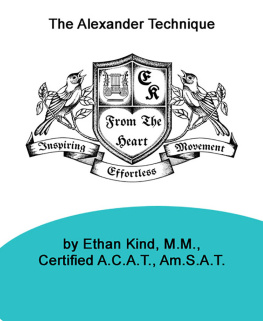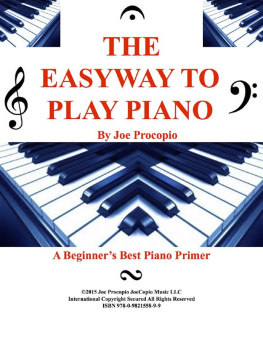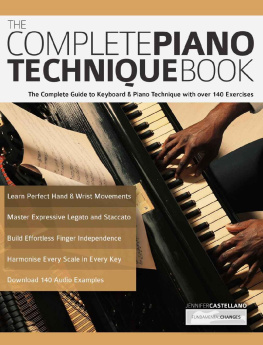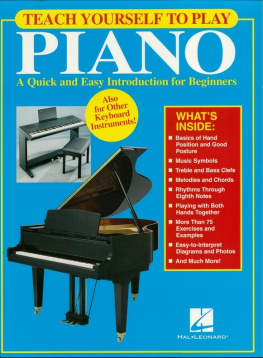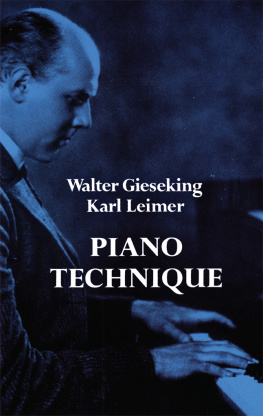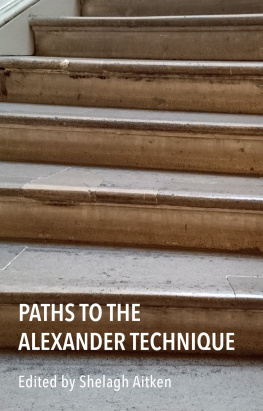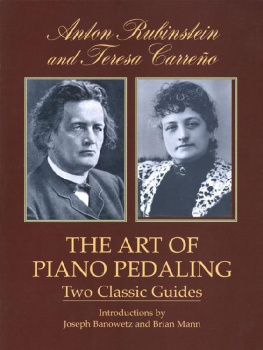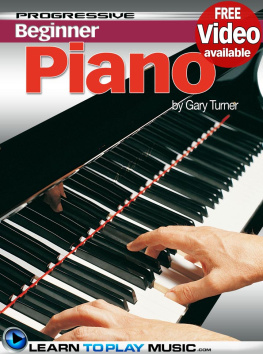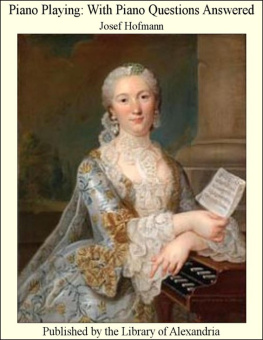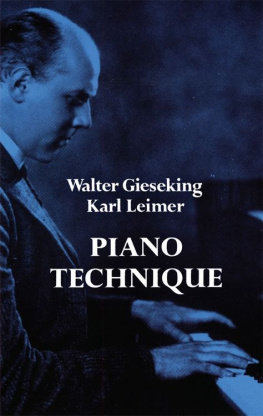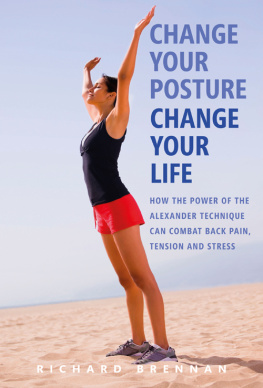
An Alexander Technique Approach to Piano Technique
Ethan Kind, M.M., certified A.C.A.T., Am.S.A.T.
Table of Contents
Alexander Technique General Good Posture at the Piano
What the Alexander Technique Has to Offer Pianists
Posture
Torso, Shoulders, and Breathing
Inhibition and Playing
Accuracy (playing with faith)
Opposition at the Piano
Hunkering Down at the Piano
An Energized Body
Unrestricted Practicing
Slow and Fast Playing, Fragments and Focal Dystonia
Guided Whole Body Release before Playing
When Youre Not Doing Something, Dont Continue to Do It
The Reasons Why Performers Resist Releasing Poor Physical HabitsAs a Gift (for everyone listening)Collected Short Essays in the Order WrittenPREFACE
This is a direct application of the Alexander Technique to playing the piano. What Im presenting here is a synthesis of my experiences as an Alexander Technique teacher workingwith pianists over the last twenty years and myself as a beginning piano student. Being abeginner at the piano as an Alexander Technique teacher has given me a learning advantagethat has helped me avoid getting into physical trouble at the piano. When it comes to solvingtechnique problems on the instrument, I bring no history as a pianist to the piano, but I do bringmy training as an Alexander Technique teacher to the instrument. To become an AlexanderTechnique teacher, I went through three years of training, and core to my training is I wastaught to approach every activity with fresh eyes, using Alexandrian principles of good bodyuse.
What Im adding into this mix is that I trained for 15 years to become a concert guitarist.I studied at the Royal College of Music in London with the guitarist with the finest technique inthe classical world, John Williams. While at the college I developed carpal tunnel syndrome andworked with an excellent Alexander Technique teacher, Jean Gibson. She was the AlexanderTechnique teacher of Sally Swift who wrote the book on dressage, Centered Riding. I learnedfrom Jean Gibson how to troubleshoot on the guitar. What I also learned from Jean Gibson wasnot only the basic principles of Alexandrian good body use, but also how to identify what isgreat mechanically advantageous guitar technique and how to put it into practice. I identifiedwhatmade JohnWilliams suchanextraordinary performer,tiedthis totheAlexanderTechnique, and I never had physical problems again on the guitar.
CHAPTER I: ALEXANDER TECHNIQUE IN GENERAL
Introduction
All of the most incredible piano playing in the world will not save your body, if yourposture is poor, and you are using too much muscle. In the Alexander Technique there areprinciples basic to all movement that we Alexander Technique teachers apply. What follows is abrief history of the technique, its principles, and its application to piano playing.
Goal of the Alexander Technique
The purpose of the Alexander Technique is to create freedom in movement by teachingnew movement patterns in the activities of everyday life and specialized activities. Its objectivefor the pianist is to produce physical responses that insure an appropriate distribution ofneuromuscular tone throughout the body. This allows the pianist to be able to deal with thestress of a performance, by creating physical lightness and ease. The technique identifies anddecreases neuromuscular tension that occurs subconsciously, and it creates postural good use through the intricate and delicate interplay of muscle coordination and movement. When thetechnique has been successfully applied, body areas are lightly and easily balanced in relationto each other, allowing increased flexibility and a sense of freedom for the pianist. The goal ofthe Alexander Technique is to change destructive physical habits which limit freedom andmovement and which create pain through straining and tension and poor posture.
History of the Alexander Technique
F. Matthias Alexander was born in Tasmania, Australia in 1869 and died in 1955. He wasan orator who aspired to being a Shakespearean actor. During his career, he began losing hisvoice while performing. Although Alexander consulted with physicians, they were unable tofind anything wrong with him. Several physicians suggested a minor operation on his throat,although they could not guarantee the success of the procedure. He eventually stopped seekingthe help of physicians and decided to observe himself reciting in a mirror. He observed that as he recited he threw his chin upward, constricting the muscles in the back of his neck, pulling hishead backward and down compressed into his spine, with his neck and jaw pushed forward.This stretched and depressed his larynx. Alexander attempted to correct the error by holdinghis head differently. He extended his head upward, but found that the correction was only oftemporary help, as he began losing his voice again. After many attempts he realized that he was still positioning his head incorrectly, and he had no idea how his head functioned in relationshipto his neck. He then decided only to inhibit the habitual manner in which he positioned hishead. He focused his attention upon not tightening his neck muscles during a recitation andallowed his head to find its own sense of balance.
Alexander expanded his observations to total body awareness and began to share hisideas with others. He formulated as his main principle that there is a relationship between thehead and the neck, and that if this relationship is freely maintained in movement and at rest,there will be a beneficial effect on the functioning of the body as a whole if the head leads alengthening spine upward, the body follows with elegant beautiful movement. Alexander calledthis head-to-neck relationship Primary Control. He defined good Primary Control as occurringwhen the head is balanced freely at the end of the spine, and the musculature is not interferedwith in its lengthening the spine to fully support the body in activity.
Orders and Inhibition in the Alexander Technique
Using orders (thoughts) to create good use, is a technique for helping the pianistrediscover the natural balance of his body. There are three steps in changing bad habits. First,the pianist must become aware of the habit. Second, the pianist is taught to observe hishabitual responses to particular stimuli. An example of a poor habitual response is the raising ofthe shoulders while playing the piano. This movement causes excessive tension in the neck andshoulders. Third, the pianist is taught to inhibit his habitual response and to allow the body tofind a balanced posture, using orders of allowance. An example of inhibiting is noticing that youtighten your neck the moment you start to play. So, you stop playing, release your neck andbegin playing with a free neck. An example of an order of allowance is, My neck is releasingand my spine lengthening, as my shoulders are floating on my ribcage.
Two conditions are necessary for orders of allowance to work. The pianist should orderonly movements that are not harmful and that are physically possible to accomplish. Second,the movementshould be trustedto happen. If the pianist does notinterfere withthe musculature consciously, the body knows the most efficient way to accomplish a movement orposture. If the pianist consciously attempts to order movement through contracting themuscles, the quality of movement will be reduced. Movement and posture require so manyvariables working together, that any conscious attempt at moving all of the musculature willblock the ease of playing your instrument.
Next page
